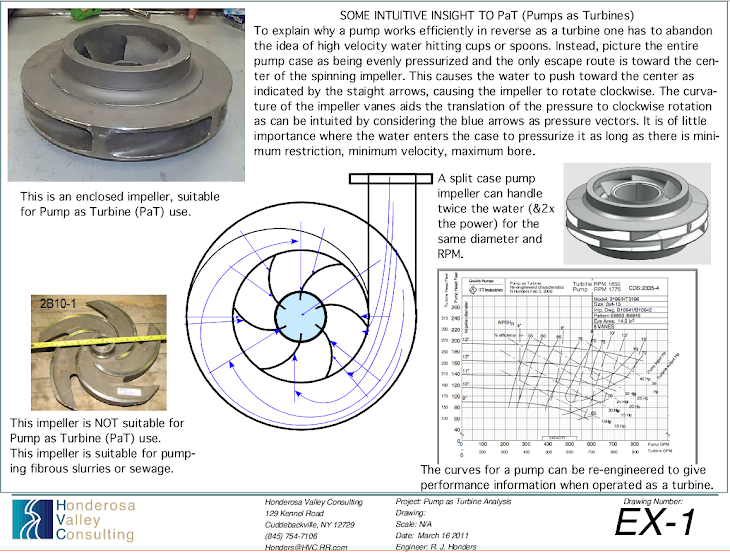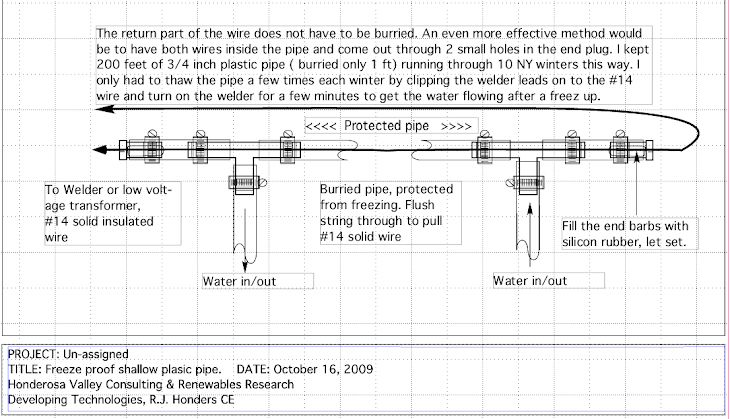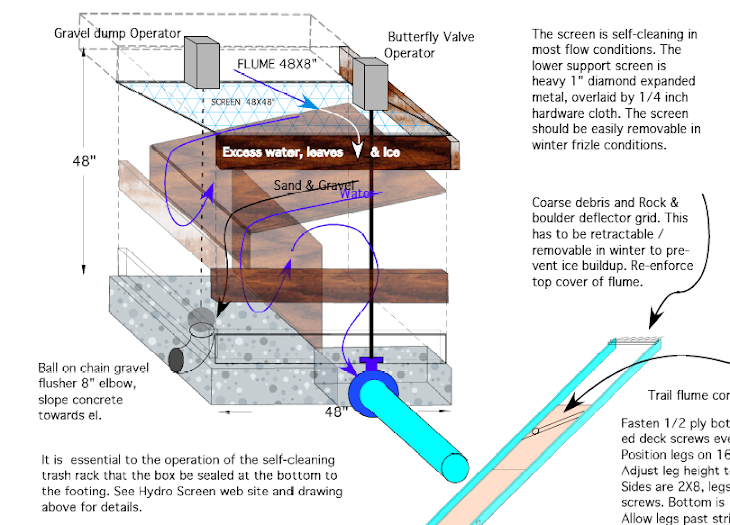Net Meter Micro Hydro – The Road to Energy Independence
By Robert Honders, Honderosa Valley Consulting
Net metering is the single most effective policy government can implement to promote renewable energy derived from all sources. Why exclude waterpower? If net metering were extended to all small scale (under 25KW) hydro sites, we would see renewed interest in the restoration of thousands of micro hydro sites that have been abandoned during the times of cheap oil. Many of these sites could be made productive again with lower investments because the infrastructure (dam, penstock, water supply) may still be intact. There is no valid reason to treat one renewable energy source any differently than another. We need them all to pave the road to energy independence.
The advantages of a grid connection include energy storage and vastly simplified control of frequency & voltage. Essentially the site runs wide open and just pushes energy into the grid at the grid voltage and frequency. It is analogous to you helping a freight train by pushing on the back of it. You won't be able to change its speed at all, even if your efforts are doubled, or stopped altogether. In other words, your energy input can fluctuate, but the train stabilizes everything just as the grid stabilizes relatively small energy inputs.
The simplest way to get grid-connected and reap these stabilizing benefits is through net metering. Net metering is accomplished using a single-bidirectional meter, which is already in place on all grid-connected homes. But beware! The newer electronic meters are programmed by the utility company to ignore the direction of the energy flow. Thus you can end up paying for the energy that you send to the grid! The power company prevents small energy producers from sharing the energy they generate with their neighbors and turning their own meter backward without permission. (Older spinning disk meters were not programmable in this way. The worst they could do to you is stand still while you were supplying power, and spin forward as you used power.)
To get grid connected with your hydro powered induction generator (cheapest, robust and most common) you’ll need to use an ‘inter-tie protection relay’ like the Beckwith M-3410. The relay monitors the grid / utility (not your generator) for any type of anomaly, like ‘grid down’, voltage or frequency too low / high etc. If any grid anomaly occurs the relay disconnects your micro hydro output from the grid for their protection. After grid power is restored the relay monitors the grid and if the grid has been normal for 5 minutes it will re-connect your micro hydro. You will need to wire an auxiliary contactor to hang a dump load (space heater will do) on your induction generator while it is disconnected from the grid to prevent your output voltage from rising too high. Below you’ll find the diagram for a system like this. Double click to enlarge.
Once your utility has inspected and tested your grid inter-tie for proper operation, AND if your state law has hydro power included in the net metering law, then you can ask your utility company to re-program your meter so you can share your excess power with your neighbors and run your meter backwards. Net metering makes it possible to ‘store’ your excess energy in the grid instead of in batteries, and returns energy to you when you need it, perhaps during a dry August, and at the same price.
So let’s have NET METERING FOR ALL RENEWABLE ENERGY be the law of the land!







8 comments:
I am doing a 15 kW grid conencted systemn in UK - grid is single phase. To operate grid connected only.
Want to use induction generator (tough and cheap)
Will run up to synch speed on spear, then connect (with some inrush current limiting)
Need to find out how to claculate capacitance needed for excitation and power factor correction.
Do you have some info or point to where I can find it?
GOOD NEWS!!!
I heard that New York State has recently passed micro hydro for net metering, sounds like now its just up to the public service commission to implement the ruling change for all the various utility providers statewide.
Passage Of Power NY Act Caps Major Year For Energy Policy In New York State
Legislature Acted on Power Plant Siting, On Bill Recovery, Power For Jobs, Net Metering and Solar Energy
June 24, 2011
(Albany) Assembly Energy Committee Chair Kevin Cahill (D – Ulster, Dutchess) announced the passage of legislation to reauthorize and improve the Article X power plant siting law, provide for an on-bill recovery program for Green Jobs-Green New York customers, and identify strategies to increase solar energy generation in New York. The bill caps off a year of major progress in energy policy in which the Legislature also overhauled the long stalled Power For Jobs program and passed significant expansions of the state’s net metering laws.
EXPANSION OF NET METERING
The legislature also passed numerous pieces of legislation amending New York’s net metering laws, which were expanded in 2008 to give non-residential customers the ability to net meter renewable power generating systems of up to two megawatts in size. The most significant (Chapter 35 of the Laws of 2011) lets farm and non-residential customers more efficiently utilize renewable energy resources by allowing the use of remote net-metering when their generating equipment is not immediately adjacent to the location of their electricity use. Bills were also passed (A 7765-A and A28-A) to expand the technologies eligible for net metering to include fuel cell and micro hydroelectric generation.
http://assembly.state.ny.us/mem/Kevin-A-Cahill/story/43398/
ACT to amend the public service law and the public authorities law,
in relation to net energy metering with micro-hydroelectric generating
equipment
THE PEOPLE OF THE STATE OF NEW YORK, REPRESENTED IN SENATE AND ASSEM-
BLY, DO ENACT AS FOLLOWS:
1 Section 1. The section heading and paragraph (a) of subdivision 1 of
2 section 66-j of the public service law, as amended by chapter 355 of the
3 laws of 2009, are amended and a new paragraph (h) is added to subdivi-
4 sion 1 to read as follows:
5 Net energy metering for residential solar, farm waste, non-residential
6 solar electric generating systems, micro-combined heat and power gener-
7 ating equipment, [or] fuel cell electric generating equipment, AND
8 MICRO-HYDROELECTRIC GENERATING EQUIPMENT.
http://assembly.state.ny.us/leg/?default_fld=&bn=A00028&term=2011&Text=Y
Looking at doing a 50kw grid intertie from a 100hp 3 phase induction motor.
The grid only has single phase around here so I would need to be operating the induction motor in a 2 phase configuration.
How is the efficency when doing this? Is 100hp (75kw) to small for such a project?
How much did that fancy interconnect relay cost as I will also need one of those...
Thanks in advance!
Kind Regards,
Jon
Hi Jon,
If you are generating 50KW with a 100HP 3 Phase motor you will generate very little additional heat in the windings when using a C-2C capacitor arrangement to get single phase and your efficiency will not be affected much either.
I would generate 480V and use a step down transformer to get your 120VAC/120VAC- 240VAC standard utility interconnect. The C-2C capacitors should be on the 480VAC side. See the diagram in my July 3, 2011 post. Your capacitors will need to be around C=500MFD, 480V oil filled (motor run caps, not start caps) and all the rest of the circuitry needs to be able to handle the 50 KW you'll be putting out.
The Beckwith M-3410A Intertie Protection relay is about $1600. Make sure your Utility Company accepts this relay or find out what they recommend.
Hi, I'm designing a pumped hydro system to use PV as energy source. Elevation and tank location is no problem. We have 200 meters or more. The idea is to provide 10 to 15 houses. 5,000 to 8,000KWh a month total. Thinking of using a battery bank and the hydro to keep it charged. This so the hydro can shut down instead of wasting water at the wrong efficiency point. What type of pump or pumps should I use for PAT?
Wow - Gregory, that is a tall order combining all these technologies in an optimal way. Pumped storage is best done with a centrifugal pump of the split case variety. You'll have to start by determining head and flow to give the required storage capacity. Then match a pump to that head and flow. Figure the whole pumped storage round trip efficiency is 60% at best. Then you might just want to stick with solar (PV) and batteries. Less costly and no moving parts to maintain to store the energy for nighttime use.
Good Luck
Rob
Post a Comment